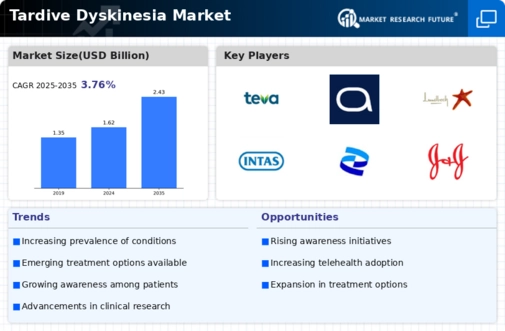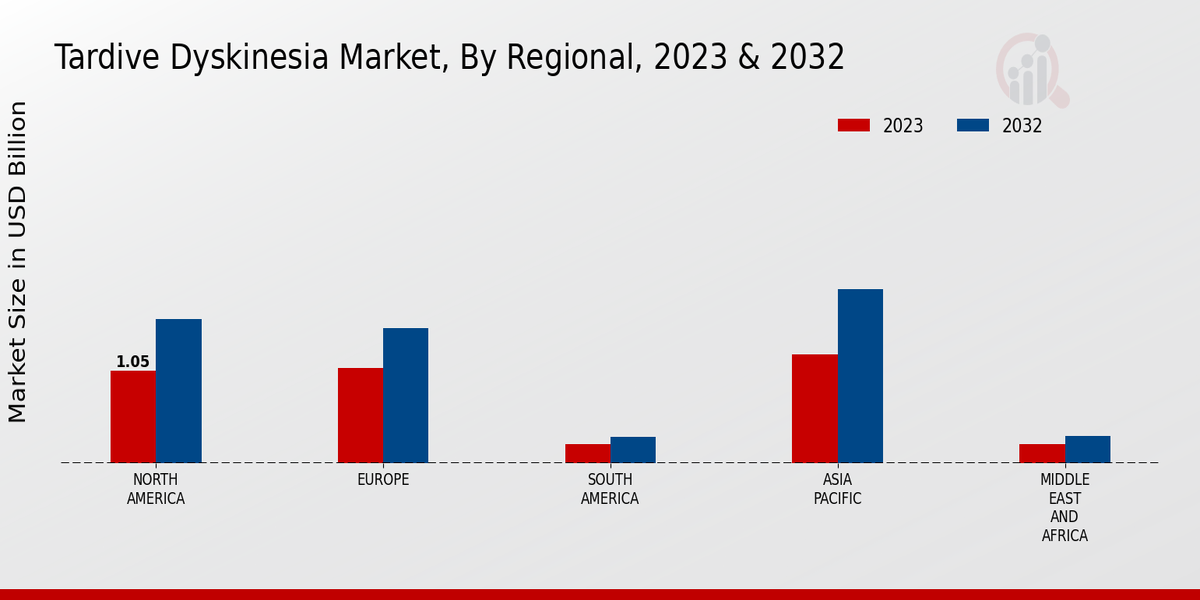Market Growth Projections
The Global Tardive Dyskinesia Market Industry is poised for substantial growth, with projections indicating a market value of 1.62 USD Billion in 2024 and an anticipated increase to 2.43 USD Billion by 2035. This growth trajectory reflects a compound annual growth rate of 3.75 percent from 2025 to 2035. The market's expansion is driven by various factors, including increasing prevalence, advancements in treatment options, and heightened awareness among healthcare providers. As the industry evolves, stakeholders must remain vigilant to capitalize on emerging opportunities and address the challenges that may arise in the Global Tardive Dyskinesia Market Industry.
Growing Geriatric Population
The increasing geriatric population is a significant driver of the Global Tardive Dyskinesia Market Industry. Older adults are more likely to be prescribed antipsychotic medications for various conditions, including dementia and depression, which raises their risk of developing tardive dyskinesia. As the global population ages, the demand for effective treatment options for this demographic is likely to rise. This trend underscores the importance of addressing tardive dyskinesia in the context of aging populations, thereby contributing to the market's growth. The Global Tardive Dyskinesia Market Industry must adapt to meet the needs of this expanding patient base.
Rising Awareness and Diagnosis
Heightened awareness regarding tardive dyskinesia among healthcare professionals and patients is propelling the Global Tardive Dyskinesia Market Industry forward. Educational initiatives and campaigns aimed at improving recognition of the disorder have led to earlier diagnosis and treatment. This increased awareness is crucial, as tardive dyskinesia can often go unrecognized, leading to prolonged suffering for patients. As more clinicians become informed about the condition, the likelihood of timely intervention increases, which may contribute to the overall market growth. The Global Tardive Dyskinesia Market Industry stands to benefit from this trend as more patients seek appropriate care.
Advancements in Treatment Options
Innovations in the treatment landscape for tardive dyskinesia are significantly influencing the Global Tardive Dyskinesia Market Industry. New therapies, including VMAT2 inhibitors, have emerged, offering improved efficacy and safety profiles compared to traditional treatments. For instance, the introduction of medications like valbenazine and deutetrabenazine has provided patients with more effective management options. These advancements are likely to enhance patient outcomes and adherence to treatment, thereby driving market growth. As the industry evolves, the market is projected to grow to 2.43 USD Billion by 2035, reflecting the potential impact of these novel therapies on the Global Tardive Dyskinesia Market Industry.
Regulatory Support for New Therapies
Regulatory bodies are playing a pivotal role in shaping the Global Tardive Dyskinesia Market Industry by facilitating the approval of new therapies. The expedited review processes for medications targeting tardive dyskinesia have encouraged pharmaceutical companies to invest in research and development. This regulatory support is vital for bringing innovative treatments to market more swiftly, thereby addressing the unmet needs of patients. As a result, the market is expected to experience a compound annual growth rate of 3.75 percent from 2025 to 2035, reflecting the positive impact of regulatory initiatives on the Global Tardive Dyskinesia Market Industry.
Increasing Prevalence of Tardive Dyskinesia
The rising incidence of tardive dyskinesia is a primary driver of the Global Tardive Dyskinesia Market Industry. As antipsychotic medications remain widely prescribed for various mental health disorders, the number of patients developing tardive dyskinesia continues to grow. Reports indicate that approximately 20 percent of patients on long-term antipsychotic therapy may develop this condition. This increasing prevalence is expected to contribute to the market's expansion, with projections estimating the market will reach 1.62 USD Billion in 2024. The growing patient population necessitates innovative treatment options, thereby stimulating demand within the Global Tardive Dyskinesia Market Industry.


















Leave a Comment